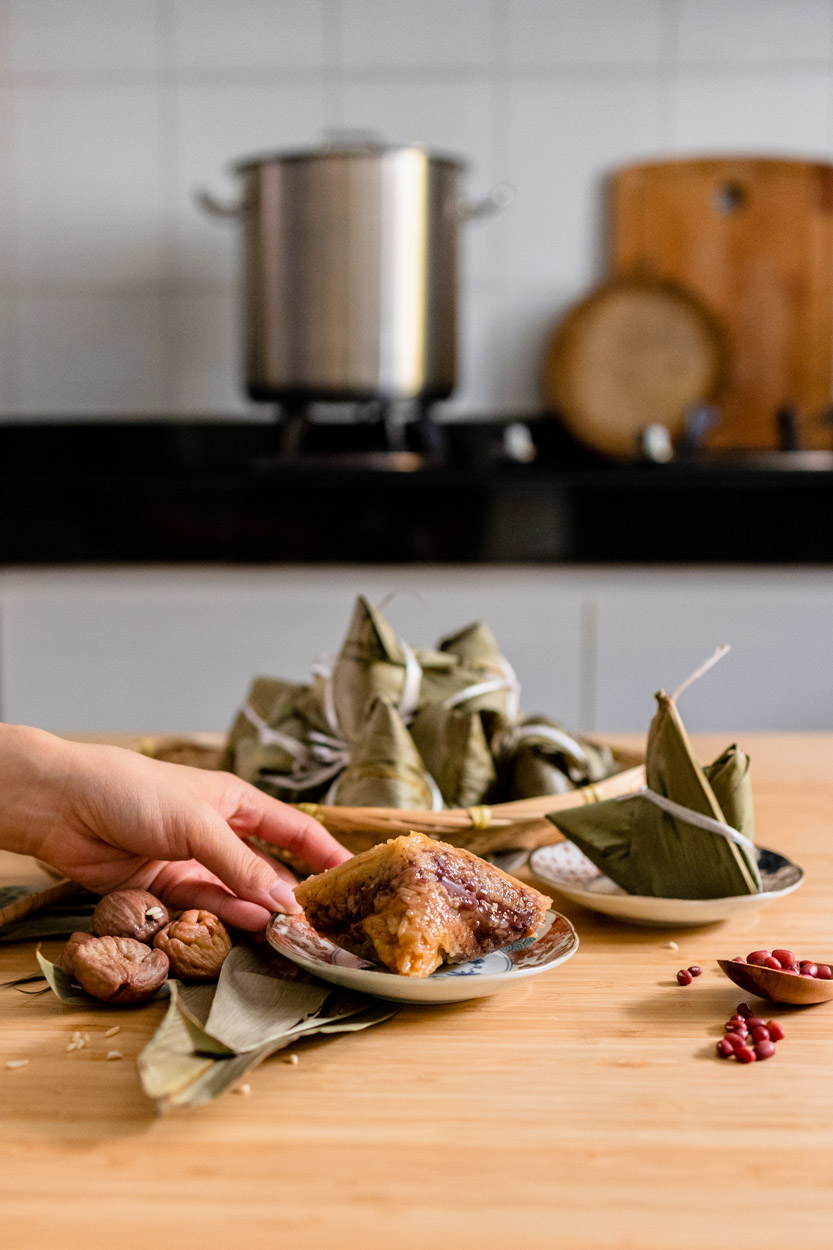
In the month of May (Chinese lunar calendar), in many countries populated with Chinese, they will celebrate the Dragon Boat Festival, 端午节. It is an important event to the Chinese, there will be dragon boat racing, consumption of realgar wine and zongzi, 粽子 which is known as sticky rice dumplings.
Hence Duanwu, which is on the 5th of May according to the Chinese lunar calendar. This year it falls on the 14th of June on a regular calendar. Dragon boat racing isn’t a tradition in the North-west of China where we grew up. But Zongzi is definitely an indispensable delicacy that makes this festival very attractive and special.
When we were young, our aunts and relative they will give us all kinds of fabulous homemade sticky rice dumplings. Our tastebuds were pampered by those delicious bamboos wrapped sticky rice. None of them tastes the same, each family are based on the recipes being passed on from their mothers or great grandmothers. I would say that each family have their own secret recipes that you can’t have outside. While we get older, we have little chance to eat amazing sticky rice dumpling, the commercial ones are just disappointing. It’s sad that our aunts are not making sticky rice dumplings these days anymore, so we decide are time-consuming but each of them is just too nice to
Actually, I’m intimate about making Zong Zi (粽子) but with Joe initiating of making it this year, we decide to challenge with the easier one. Sticky Rice Dumplings can come in sweet or savoury, unlike the savoury ones, the plain or sweet one is rather easy to achieve for a beginner like us. At first, I was reluctant but I’m glad she suggested it as it’s such an amazing tradition to continue and pass on.
The Tale of Dragon Boat Festival
There are so many mystic tales of the Dragon Boat Festival. The most famous one is to celebrate in memory of Qu Yuan, a famous patriotic poet. The story best known in modern China holds that the festival commemorates the death of the poet and minister Qu Yuan (c. 340–278 BC) of the ancient state of Chu during the Warring States period of the Zhou dynasty. Qu Yuan became a water spirit after his death, where there are a variety of ways one might appease a ghost but the best and most enduring is to give it food.
For years after Qu Yuan’s death, his supporters threw rice in the water to feed his spirit, but the food, it was said, was always intercepted by a water dragon. After a couple of centuries of this frustration, Qu Yuan “came back” to tell the people to wrap the rice in bamboo leaves, so the dragon couldn’t eat it – and become now Sticky Rice Dumpling. Well, there are many version of the myth, but the good things that we can enjoy this food.
Sticky Rice Dumpling with Red Bean
There is a large variety of Zongzi across China. They differ in size, shape and filling. There are broken down into two types, savoury and sweet. While the sweet usually consist of lye water Zongzi with different types of fillings like red bean, chestnut and dates. While the savoury having meat as the main filling is very popular in the southern regions of China such as Shanghai, Canton, etc. You may also find them filled with salted egg yolks, chestnuts, dried shrimp, etc. Obviously sweet and savoury Zongzi are very different in taste, but as a beginner, we decided to give the sweet dumpling a try.
Bamboo Leaves
The main star of this snack, you can’t complete it with them! Many of you will be familiar with banana leaves and pandan leaves, but bamboo leaves might be new to some of you. Bamboo leaves are harvested when they are no more than thirty centimetres in length and five centimetres in width, and they have a mild, sweet taste with faint notes of green tea.
If you are using dried bamboo leaves. Soak the bamboo leaves in the water for up to 4 hours or overnight till it is soft, using a cloth clean of the dirt. You could also boil them in a pot of water for 8 minutes, till it is soft and turn green.Leave aside to cool.
If you are using fresh bamboo leaves. It is easier to prepare the fresh bamboo leaves, soak them in a pot of boiling water for 2 minutes. Leave aside to cool.
Red Bean Paste
Red beans (aka azuki beans) are widely used in Northern-style sweet Zongzi. In our recipe, we put homemade red bean paste in the middle. We also like putting a chestnut in each Zongzi to add a different sweet taste. In fact, you can be flexible and creative with the filling. For example, mung beans and dry fruits work well too. Just remember to soak hard ingredients like beans overnight beforehand.
We make our red bean paste from scratch, it is time-consuming but easy to make. If you have a pressure cooker it will make the whole process easier. However, if you don’t have one like us remember to soak the azuki red bean overnight. Boil it in the water till it is easy to mash with a fork, only add in your rock sugar only have the red bean is cooked. We use red bean is to sugar a ratio of 3:1. However, if you are one that doesn’t like sweets, you could reduce the amount of sugar.
Glutinous Rice
Glutinous rice 糯米 (also called sweet rice) is the major component of the filling. It is the only type of rice suitable for making rice dumplings. Look for a good brand of glutinous rice, there are two types of rice, long and round type. Here we are using the long glutinous rice.
Rinse and soak the rice. Rinse the glutinous rice a few times under running water until the water is clear. Soak the glutinous rice in water overnight (or at least four hours). Add lye water aka alkaline water. Drain the water away and mix with lye water. Set aside for wrapping the zongzi.
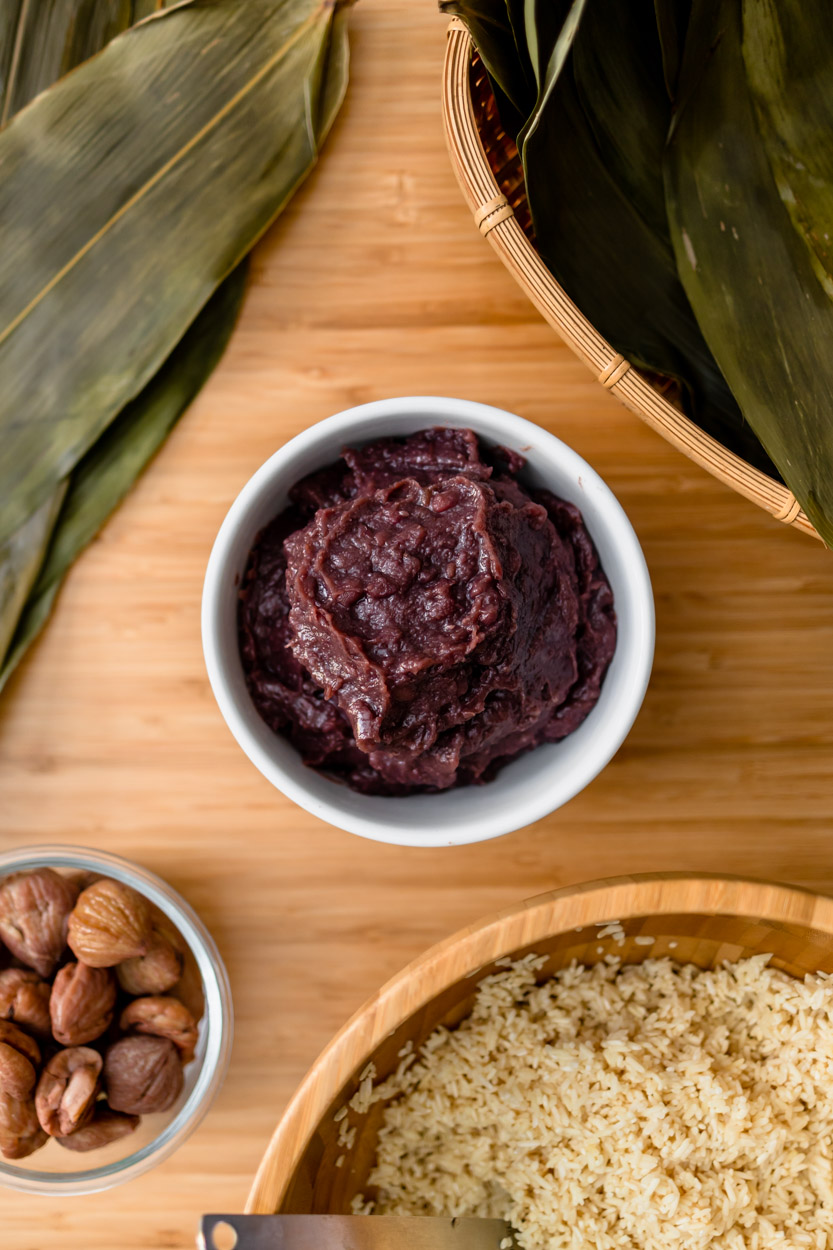
How to wrap the dumpling?
There are many ways to wrap one and the commonly seen one is in a triangle shape which is what we are going to show you. As it is the first time we made them, we tried a few times before we got this perfect ratio recipe.
- Use two wide bamboo leaf to form a narrow cone.
- Place some glutinous rice in, then the filling – red bean paste and chestnut. (The perfect ratio is two scoops of glutinous rice, one scoop of red bean paste and one chestnut!!)
- Top with more rice (The perfect ratio we used are one and a half scoop) and make it level.
- Fold the two sides of the leaf over the rice.
- Then fold the top of the leaf down to cover the rice completely.
- Wrap the rest of the leaf around the shape. Tie with a cooking string. (If you use the zongzi twine, soak it in a bowl of water for half an hour before using it. The twine will rehydrate and won’t break easily.)
Note that it is important to tie them tightly since we want to cook them for a few hours. As for the knots, nearly everyone will cut the twine when they want to eat. Therefore, it does not matter whether you can easily open the knot. Make sure you end it with a tight knot to avoid the dumpling breaking when cooking.
How to cook the Sticky Rice Dumplings?
Cooking zongzi is simple but lengthy. You can schedule it when you are at home, in which you can do another thing while cooking. There aren’t many things you need to do after you set the pot on the stove. Just wait and add some water occasionally if necessary.
Use a stockpot. Bring a large pot of water to a boil. The amount of water should be enough to submerge all the zongzi. Boil for three hours. Boil over low heat, i.e., reduce to a bare simmer for about six hours. Add only boiling water. Check the water level from time to time. Maintain the level of water to just enough to submerge all the zongzi. Add only boiling water when necessary.
It is advised to make in bulks, expertise level like my aunts, they make at least 100-200 pieces at one time during the festival season, our recipes are good with 15 dumplings. After boiling them in one go, you can cool and store them in the freezer.
Steam it for 10 – 15mins when you when to eat it.
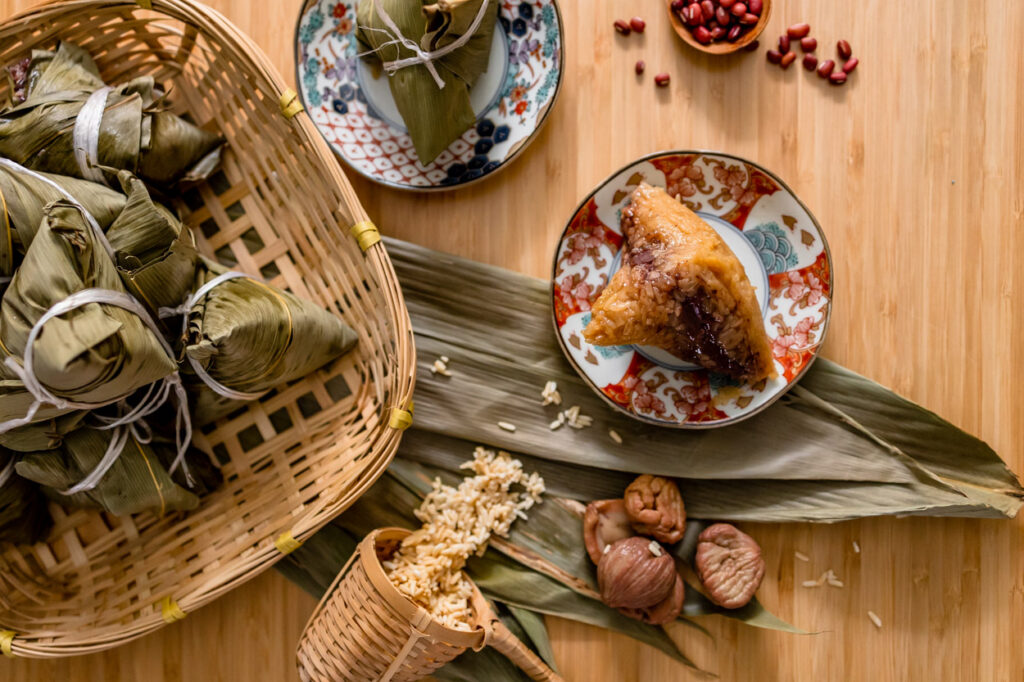
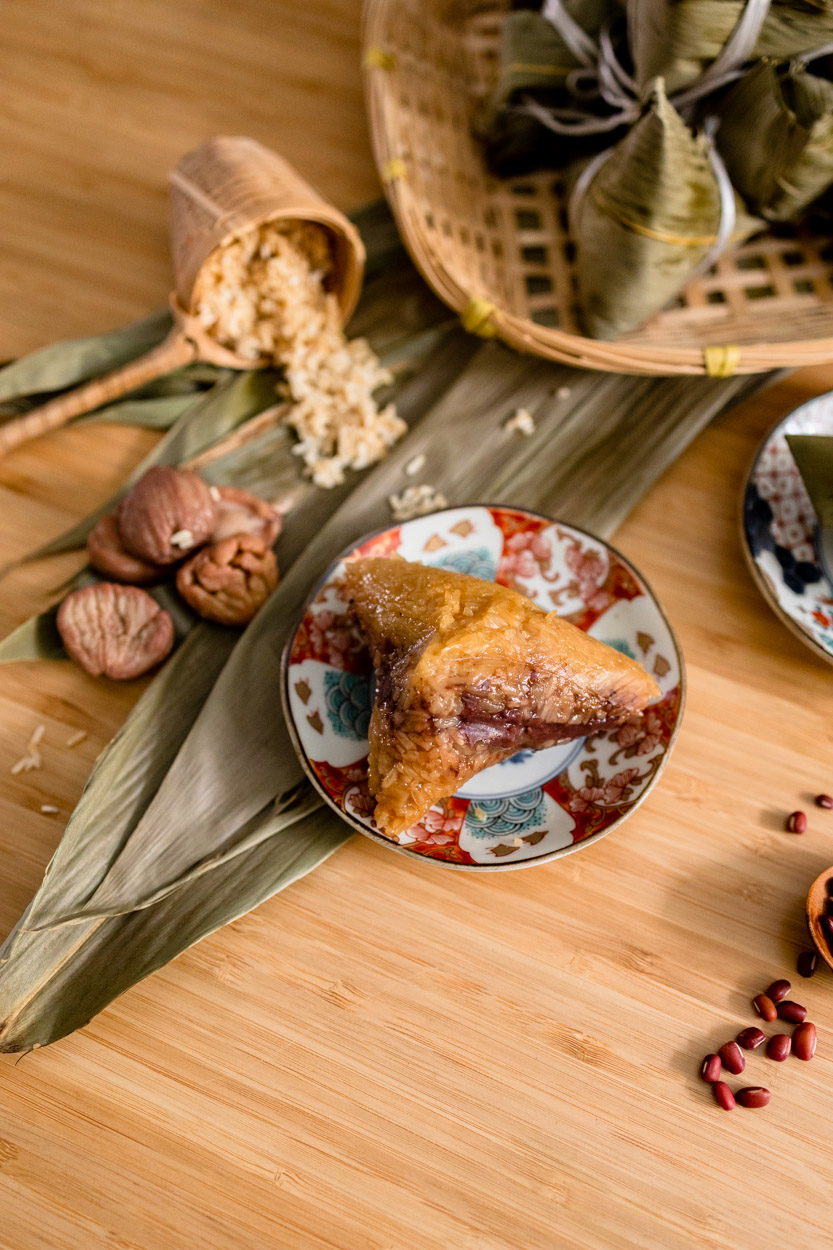
Cooking points to take note
While it is still not perfect as we are still inexperienced, here are some cooking tips to we have learn during this process;
- Moreover, when we unfold the leaves, the rice dumpling may crack, deformed and stick onto the leaves. It is messy, and certainly frustrated. A little bit of vegetable oil in the rice prevents the rice from sticking to the bamboo leaves.You could also brush a thin layer of oil on the leaves before wrapping.
- Too much lye water will result in a bitter taste, and too little will not yield the beautiful amber colour and signature chewy texture we’re looking for. Measure carefully!
- A few of our rice dumpling “leaked”. Don’t wrap the twine too tightly when securing the bamboo leaves, as the rice needs room to expand when cooking.
This is a two-day process, so I’ve broken down the recipe into three parts: the day before, the night before, and the day of assembly! There are so much to learn from this simple traditional snack, can’t wait to improve the recipe and share it with you soon.
xoxo, Angela
Red Bean Sticky Rice Dumpling | 红豆碱水粽
Ingredients
30-40 dried bamboo leaves
1 kg of glutinous rice
1 ½ teaspoons lye water
1 cup of homemade red bean paste
15 dried chestnut
Methods
- The Night Before: Soak the rice and bamboo leaves
- Rinse the sweet rice a couple of times until the water runs clear rather than cloudy. Next, transfer the rice to a large bowl with enough water so that the water line is ½-inch above the rice. Stir in 1½ tablespoons of lye water and ½ tablespoon vegetable oil. Once the lye water hits the freshwater, both the rice and water will turn a light yellow colour––that’s normal. Soak the rice, covered, in the refrigerator overnight.
- In a large basin (or your kitchen sink), soak the bamboo leaves overnight. Weigh the leaves down with something heavy to make sure all of the leaves are submerged.
- The Next Day
- Clean each bamboo leaf, front and back, with a clean kitchen towel, shaking off any excess water and trimming off about a half inch of the bamboo leaf at the base (this part is too tough and rigid to handle). Set aside.
- Take the soaked rice out of the refrigerator, and drain off all of the liquid. Set it aside.
- Take out the red bean paste, and divide it into 15 equal-sized balls.
- Now you’re ready to assemble the zongzi! Take two bamboo leaves and follow the steps shown in the photos, tying them off with kitchen string. Each rice dumpling takes about 3 tablespoons of soaked rice and one portion of red bean paste and one chestnut. Just remember not to tie the string too snugly, as the rice will need room to expand during the cooking process. After unwrapping a zongzi, it shouldn’t look like it has been wearing a pair of pants that’s two sizes too small. 🙂
- In a large pot, arrange the zongzi neatly, and fill the pot with water–about 1-inch above the top of the zongzi. Add 1 ½ teaspoon of lye water to the pot, and place a heat-proof bowl or plate on top of everything to weigh down the zongzi. Bring the water to a boil, and then turn the heat to medium to slow cook the zongzi for 2½ hours. Check the water levels periodically, replenishing the pot with boiling water when the waterline falls below the top of zongzi.
- After 3 hours, turn off the heat, and take out the zongzi to let them cool. Serve the zongzi at room temperature with sugar or the syrup of your choice!

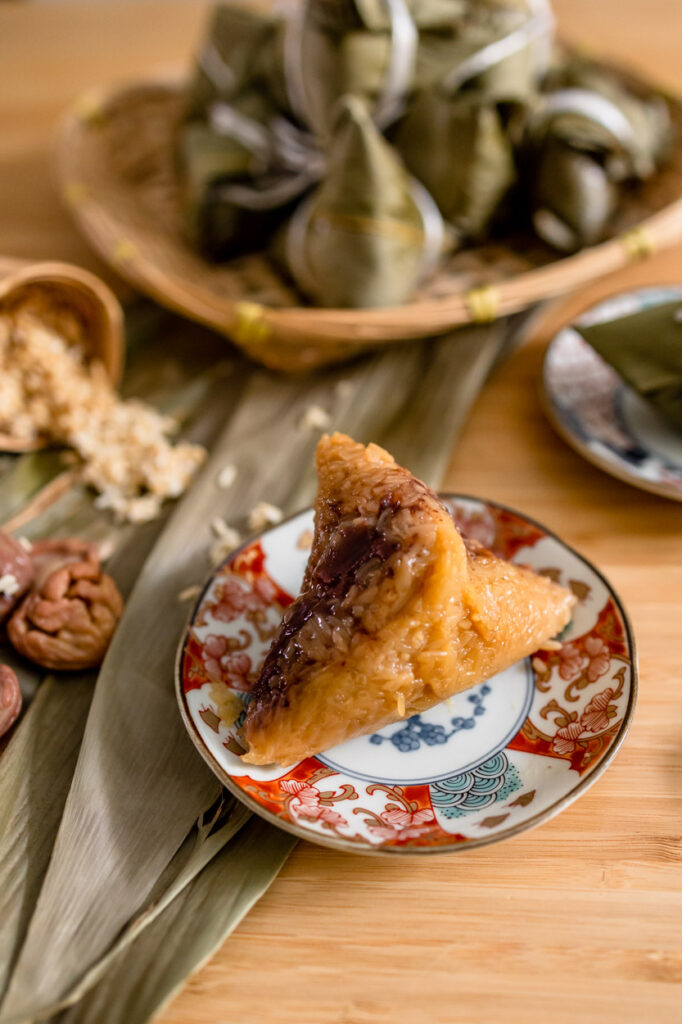
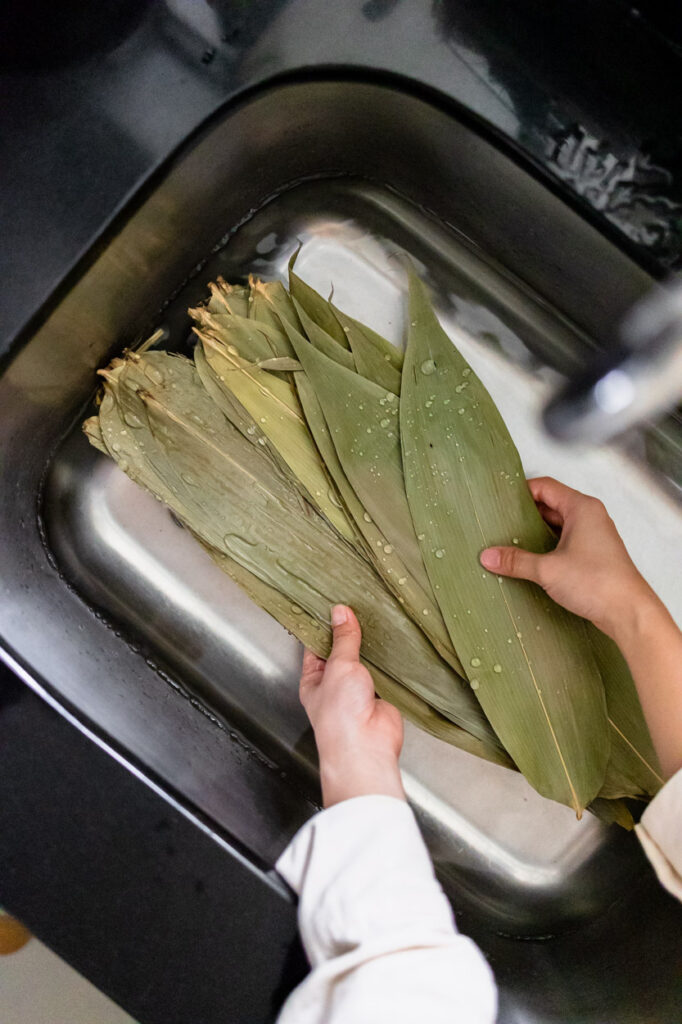
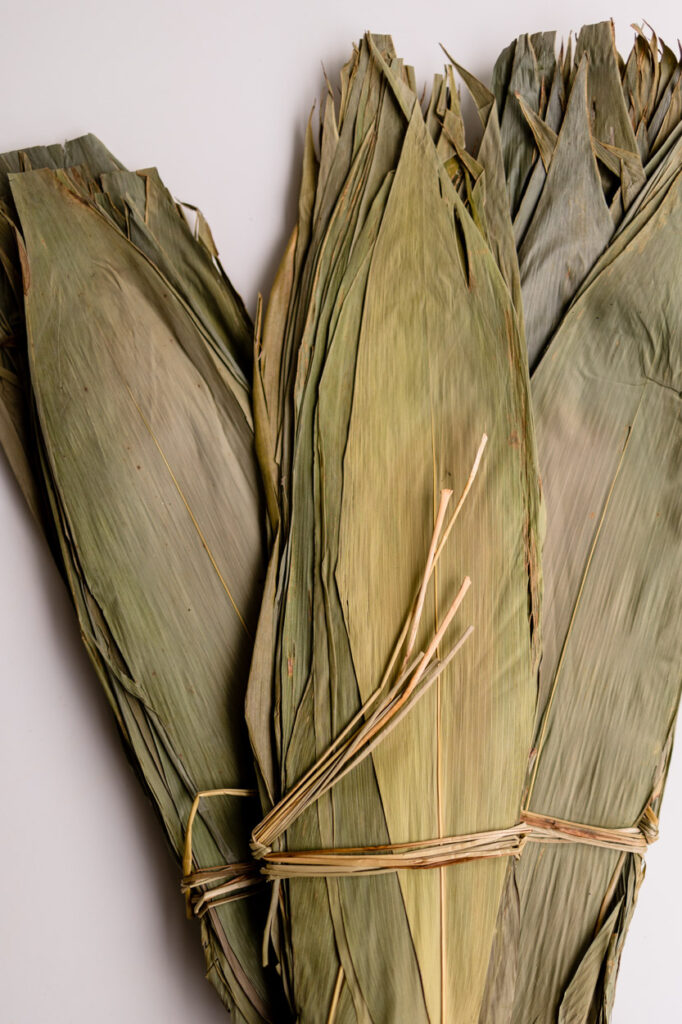
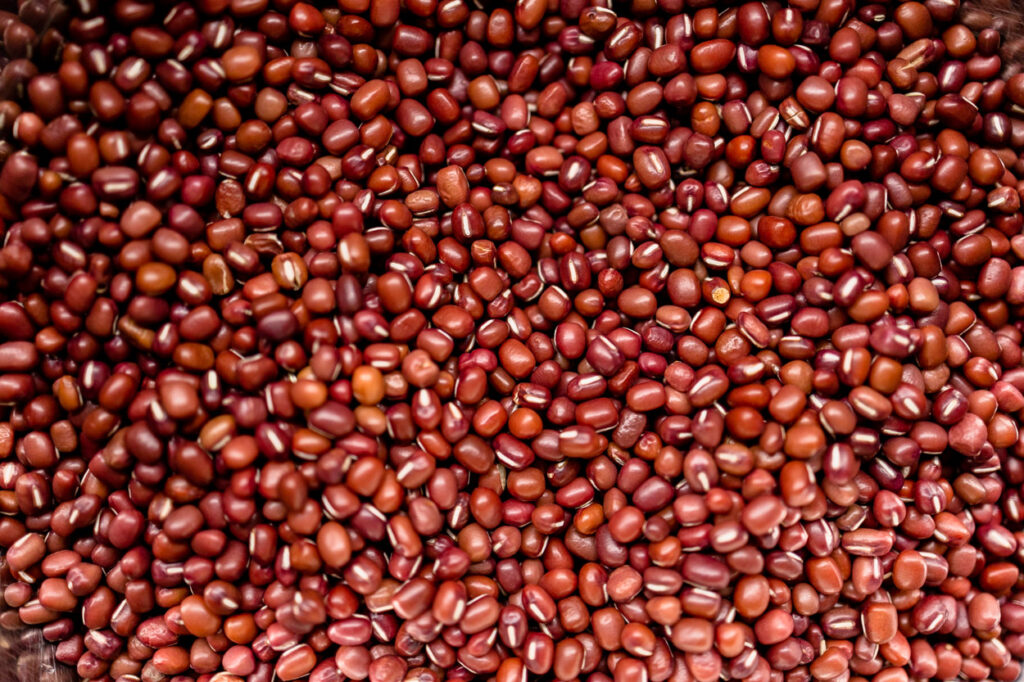

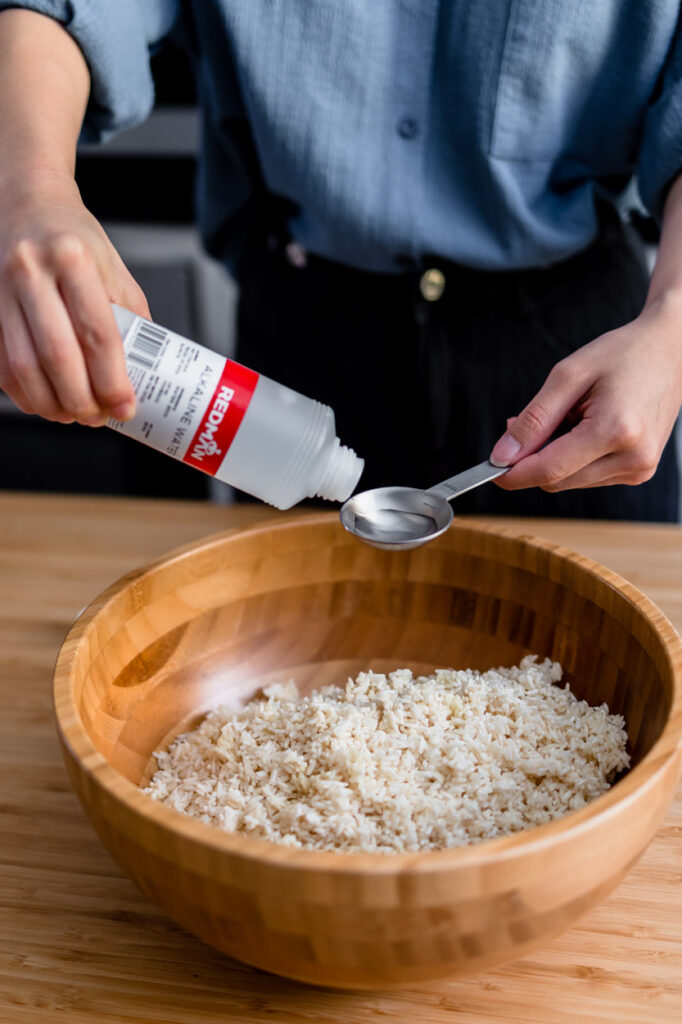

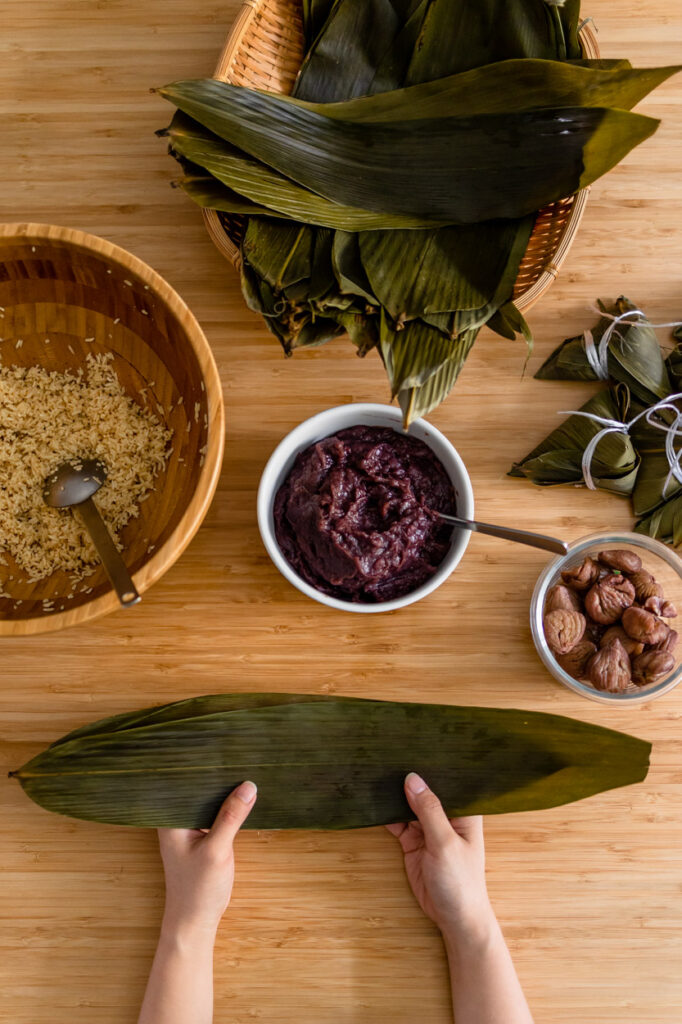
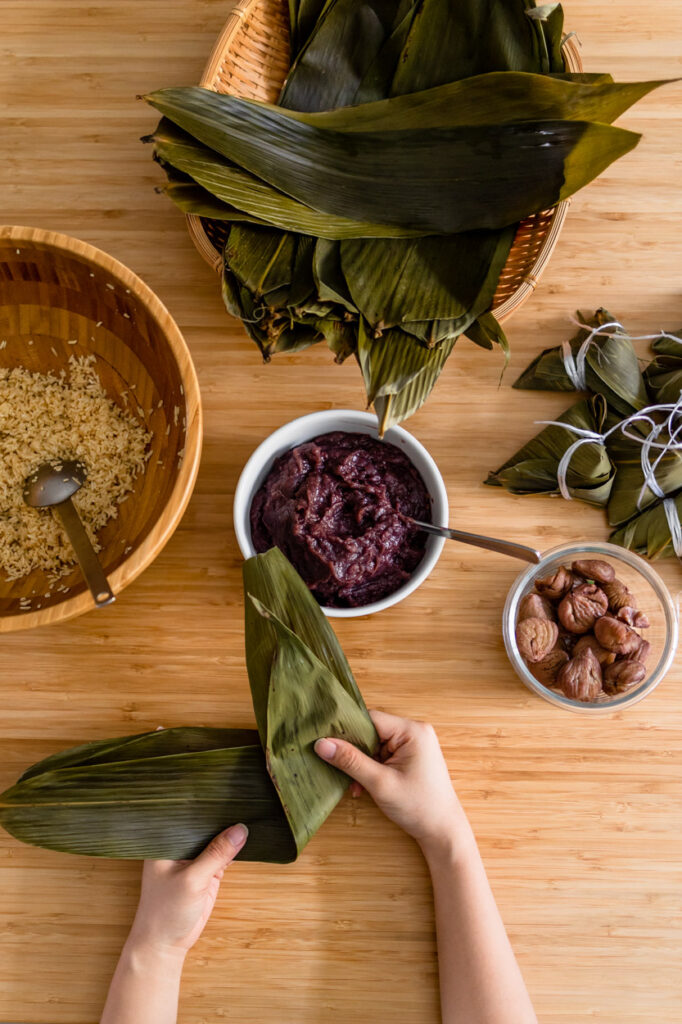

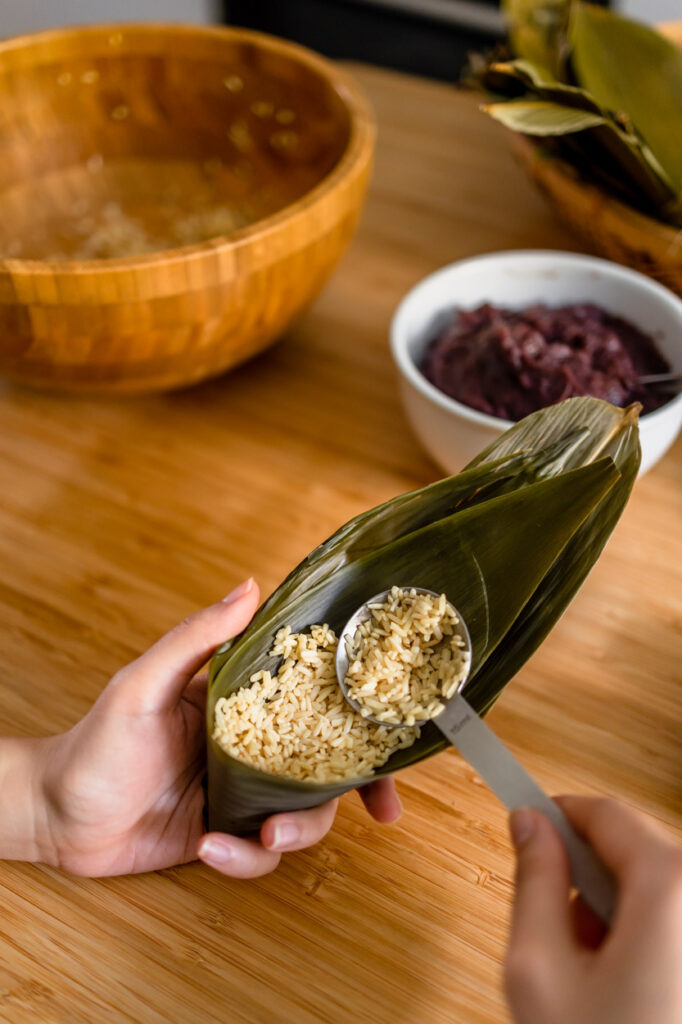
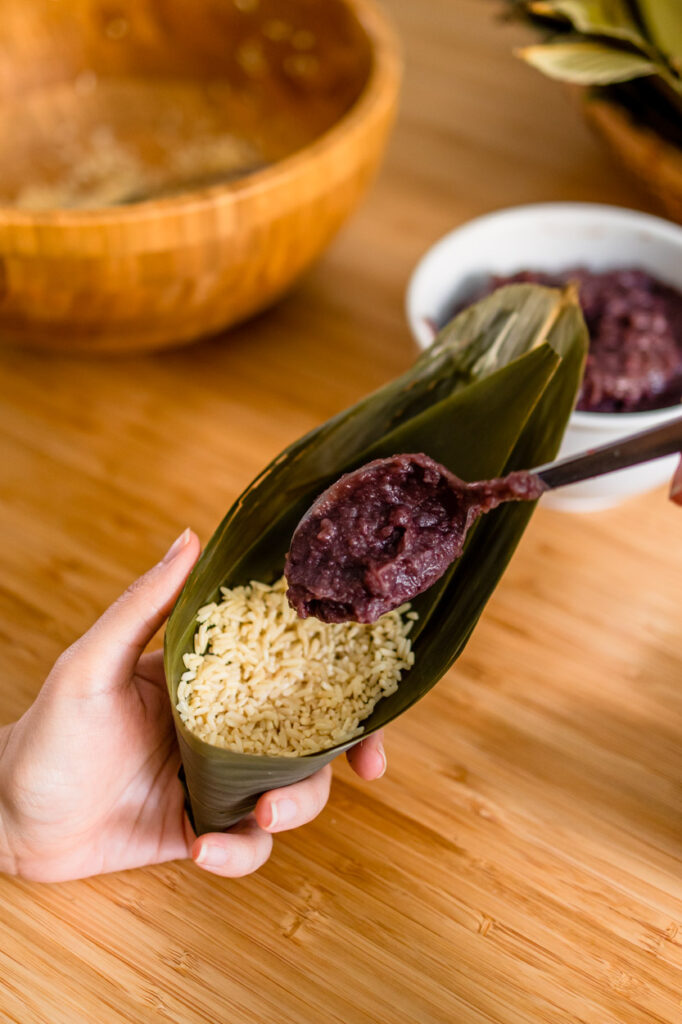
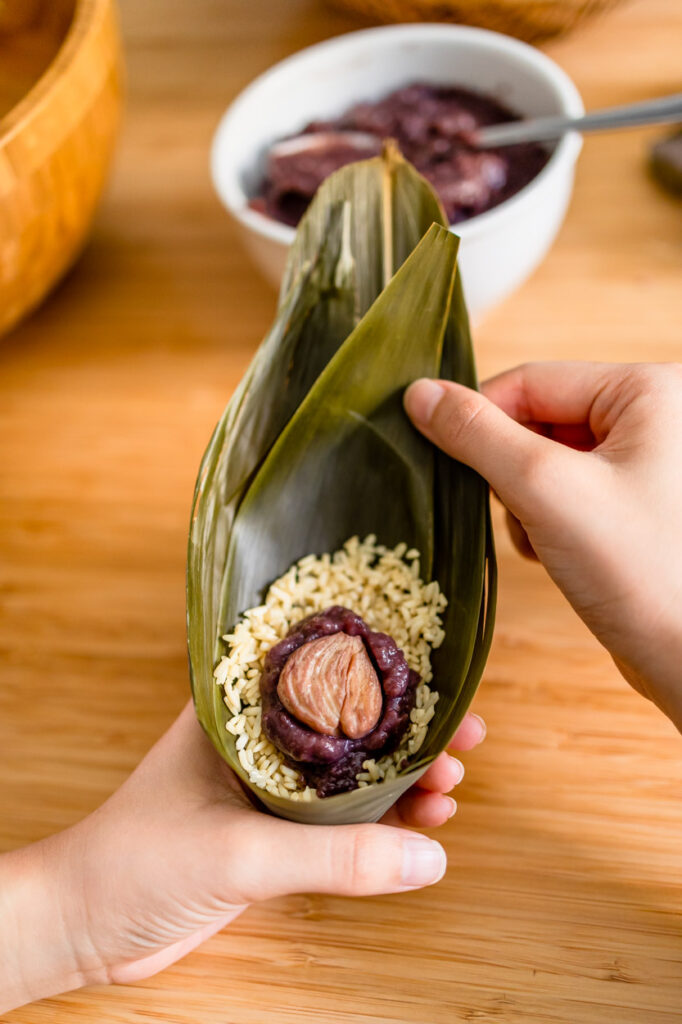

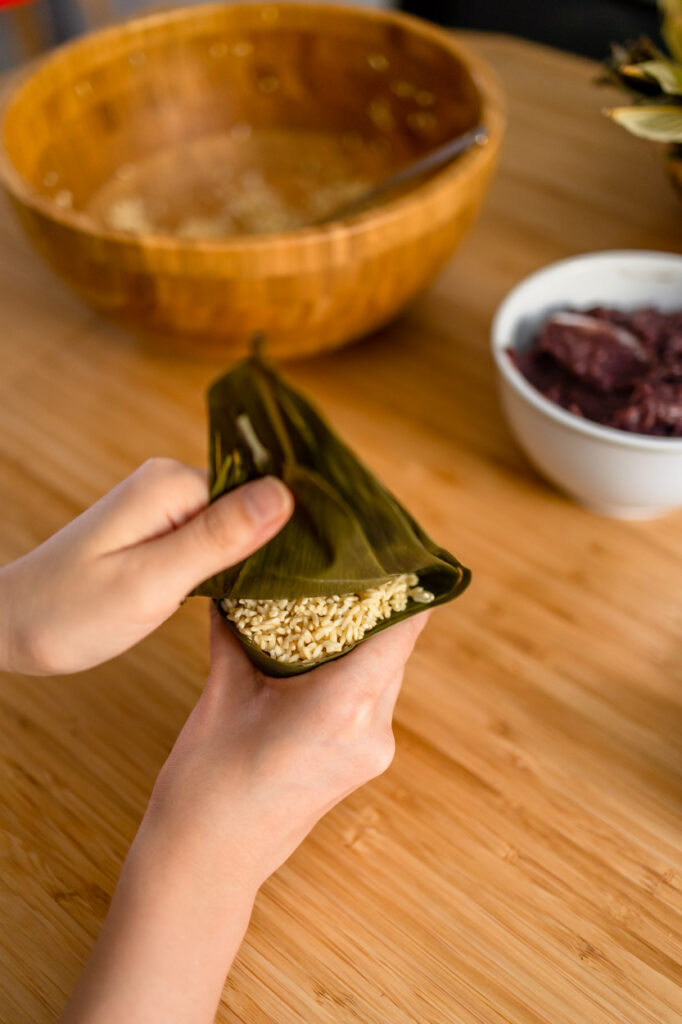
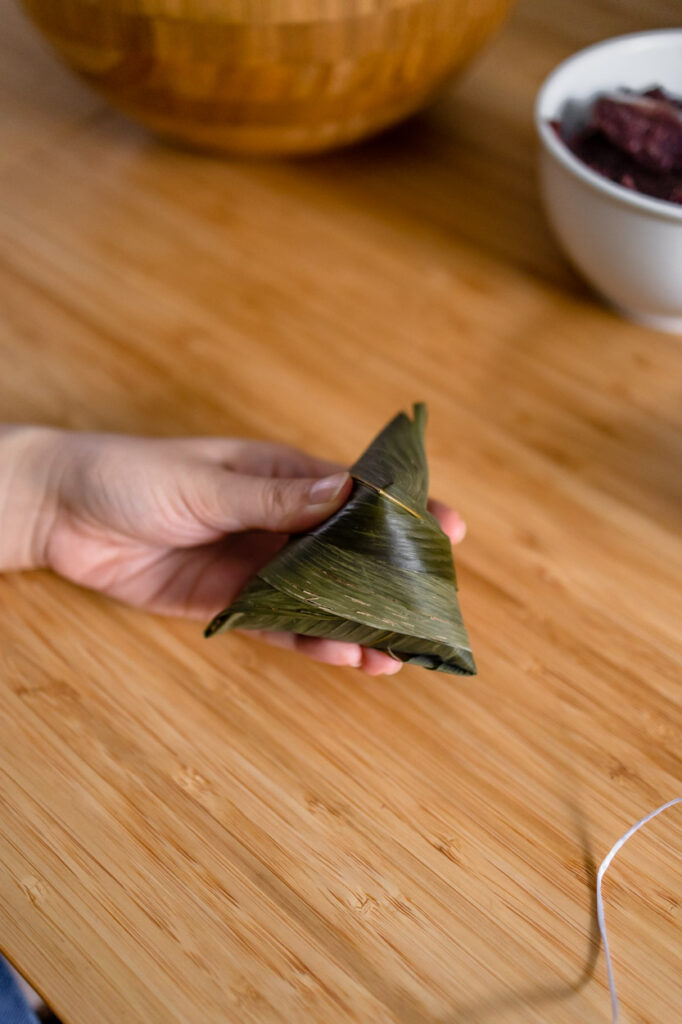
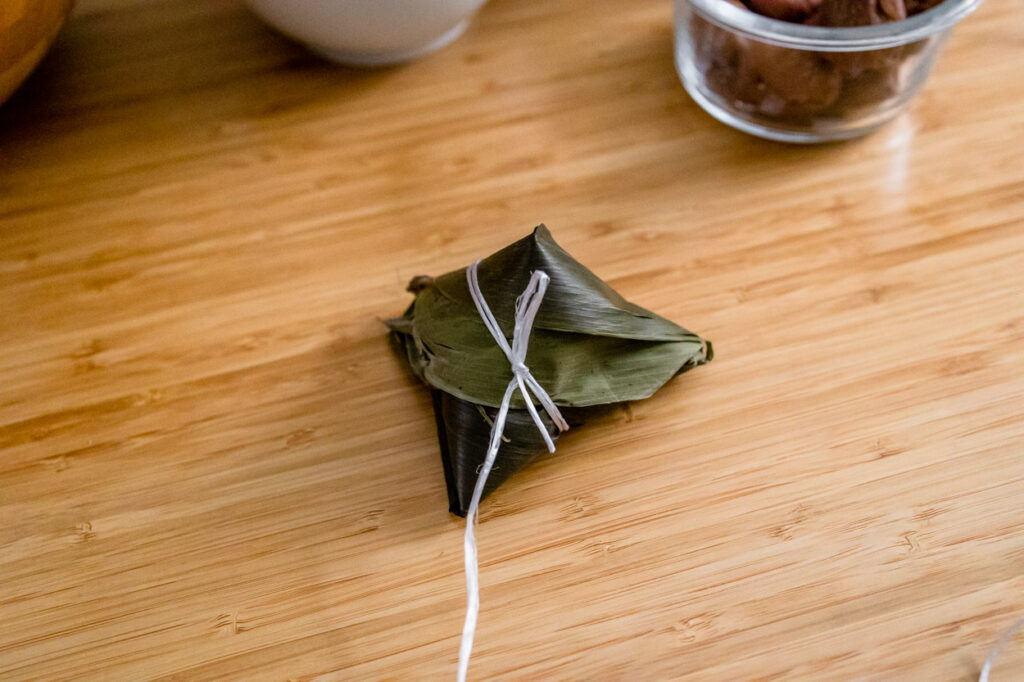
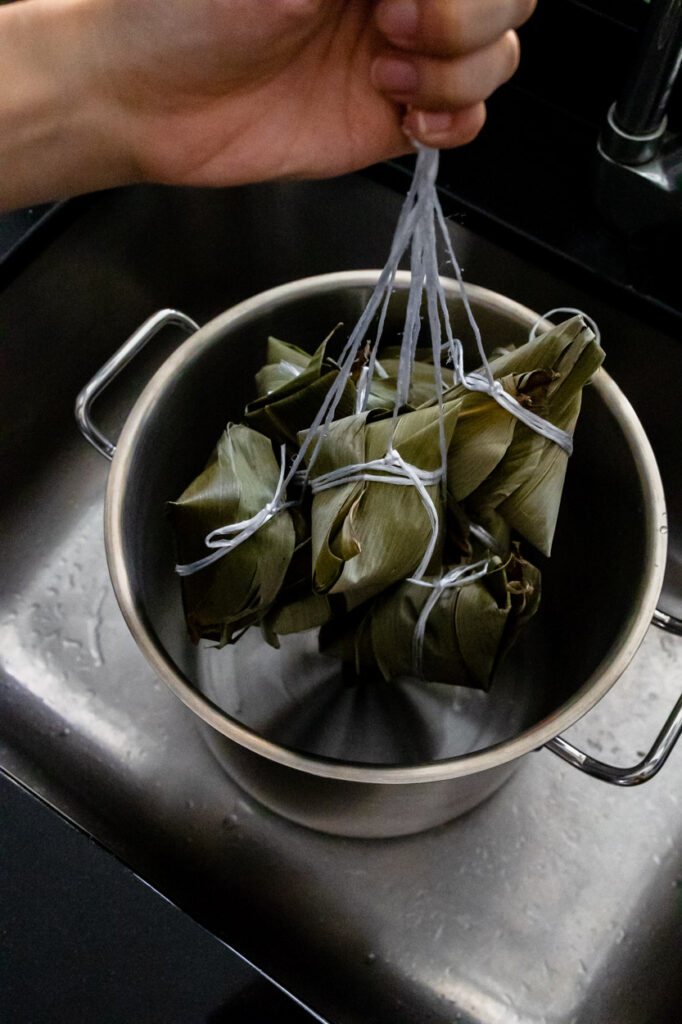

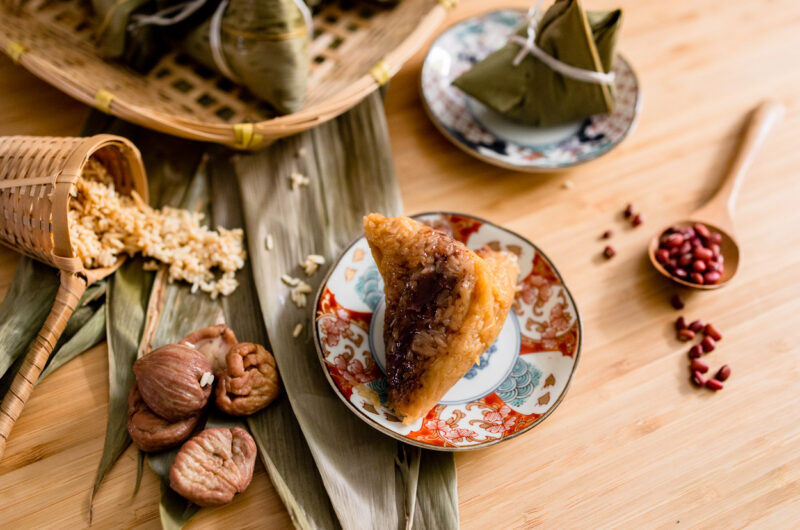

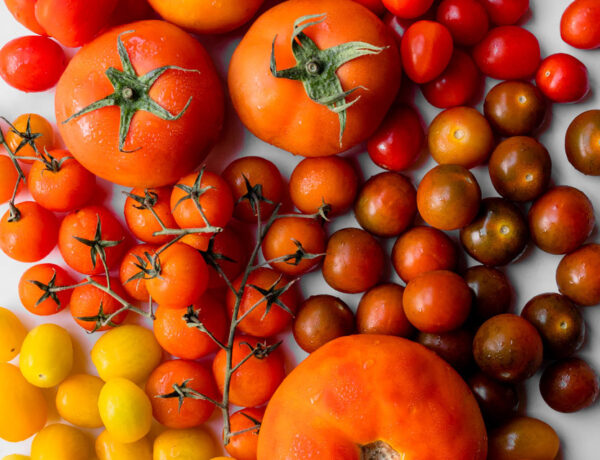
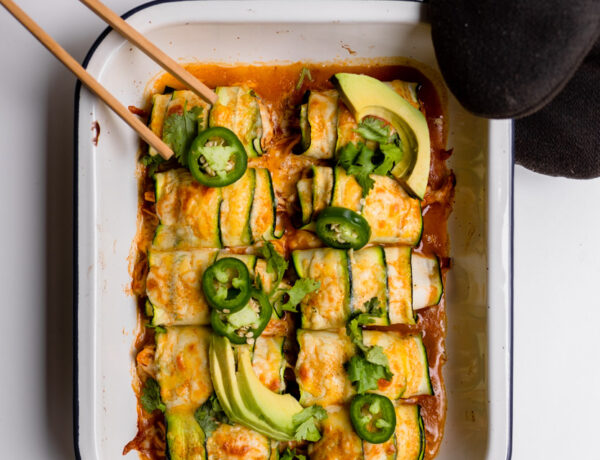

No Comments